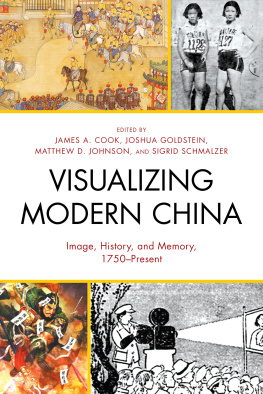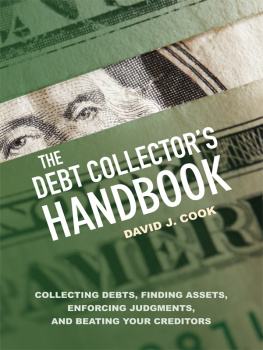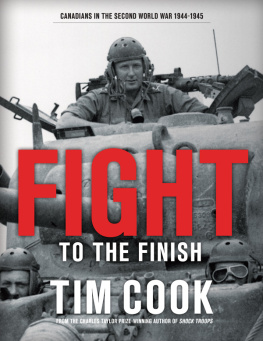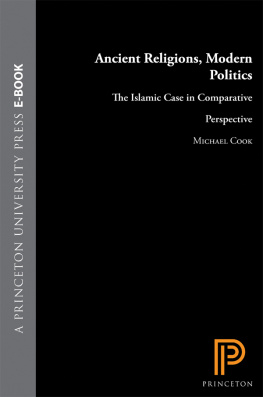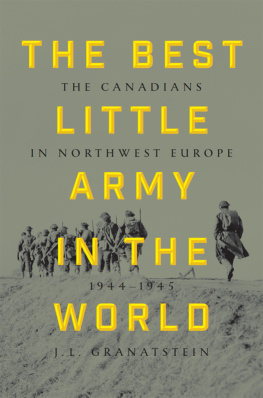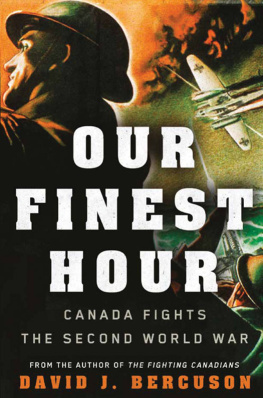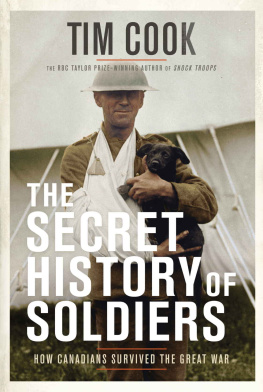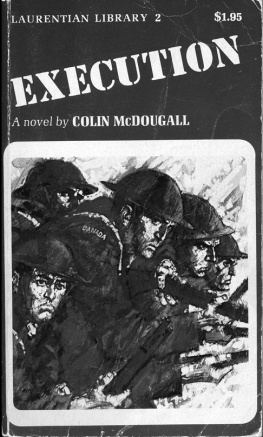

For Dr. Terry Cook,
who taught me how to be
an historian and a man
(19472014)
Also by Tim Cook
No Place to Run
Clios Warriors
At the Sharp End:
Canadians Fighting the Great War,
19141916, Volume One
Shock Troops:
Canadians Fighting the Great War,
19171918, Volume Two
The Madman and the Butcher:
The Sensational Wars of Sam Hughes
and General Arthur Currie
Warlords: Borden, Mackenzie King,
and Canadas World Wars
CONTENTS
MAPS AND DIAGRAMS
INTRODUCTION
THE WAR AGAINST HITLER
The Second World War casts a dark shadow across the twentieth century. The enormous battles that raged from continents to oceans, and in the skies, continue to fascinate and horrify us. Entire societies were transformed into enormous war machines to meet the needs of Allied and Axis air, land, and sea forces. Civilians became as much a part of the war effort as the men and women in uniform and consequently they were, in the minds of all political and military leaders, legitimate targets. Willing war workers and hapless civilians alike were killed by ordnance and weapons that made no distinctions between classes and genders, between the firing line and the home front. The combined death toll of combatants and bystanders was nothing short of staggering: in round terms, some sixty million people were killed. Hundreds of millions more were scarred forevereither physically maimed or psychologically traumatizedby the conflict.
The Second World War was not just one war but a series of campaigns and battles around the world. These campaigns brought together millions of men and women to fight the so-called Thousand Year Reich that Adolf Hitler had created to unleash war and genocide on Europe. The war pitted the Axis powers of Germany, Italy, Japan, and a number of less influential nations against the Allied powers of Britain, its dominions and coloniesprimarily Canada, Australia, New Zealand, Newfoundland, South Africa, and Indiaalong with France, the Soviet Union (an antagonist turned unlikely ally in the summer of 1941), the United States (after December 1941), and other nations. It began, arguably, in the Far East, when Japan went to war against China in 1937, and it didnt end until Japan capitulated in August 1945, a few months after Germany was defeated. This worldwide conflagration caused the massive dislocation of populations, set the stage for the postwar decolonization of Asia and Africa, and remade the international order through the toppling of Nazi Germany, the reduction in status of Britain and France, and the creation of two new world leaders: the United States and the Soviet Union. At wars end, with Europe exhausted, those two ideologically opposed superpowers almost immediately plunged into the Cold War, which lasted five decades and brought the divided world to the brink of nuclear annihilation.
The Allied victory was no foregone conclusion. Many people believe that brute force wins wars, that the enemy is driven into defeat by the side with more guns, tanks, planes, and warships. But history is replete with examples of battles, campaigns, and wars in which smaller forces drove their larger, lumbering foes from the field. Achieving victory requires more than blindly battering the enemy into submission. Numerous factors affect the combat performance of armies (and navies and air forces); these range from superior command, to the application of strength against weakness, to the coherence, motivation, and endurance of combatants in battle. Technological advances and new weapon systems can even the odds, reverse defeat, or deliver victory.
Nevertheless, for several decades, most historians have been guided by the belief that the Allied military forces smashed Germany and its co-belligerents into submission by simply overwhelming the oppositions fighting formations. Some raw numbers support this thesis: the Axis powers gross population of 191 million was dwarfed by the Allies 345 million, who were further backed by hundreds of millions more citizens in colonies and dominions throughout the British Empire. Similarly, the Allies production advantageespecially after the industrial and economic might of the United States was added to that of Britain and the dominionssuggests that no outcome was possible except an Allied victory. The Axis powers, according to this argument, were out-produced to death.
And yet, it is one thing to mobilize the industrial capacity of a nation and fully another to apply that might on the battlefield. Material superiority is never decisive in itself. How warriors and weapons systems are wielded in battle through coherent doctrine, ethos, and tactics is crucial. Long wars allow for a constant appreciation of technology and weapons by scientists. War-fighting skills evolve constantly and frequently to make the difference between winning and losing. In this regard, the Allies proved to be more effective than the Axis during the Second World War. In writing this book, rather than embracing the brute force thesis, I have chosen to show how soldiers, airmen, and sailors fought, focusing on the evolving tactics, doctrines, weapons, logistics, and technology they employed. The Canadians, in particular, had to find ways to fight effectively against a skilled enemy in conditions that ranged from the sweltering heat of Sicily to the frigid waters of the North Atlantic, and from the narrow streets of Ortona to the dark skies over Germany. At the same time, I have examined the equally important factors of morale, discipline, and fortitude of the Canadian citizen-soldiers, sailors, and airmen, and have tried to show how these young men coped while under fire. These Canadians would surely have scoffed at the notion that their victory was preordained, especially as they witnessed the death and destruction that was visited upon their comrades and friends.
While the carnage overseas was relentless, Canada was almost entirely spared from the wars ruin. Nevertheless, the country, with its modest population of fewer than 12 million, embraced its role as an arsenal of democracy, exporting war supplies, feeding its allies, and raising a million-strong armed force that served and fought in nearly every theatre of war. Under the steady, if slippery, hand of Prime Minister William Lyon Mackenzie King, the governing Liberal Party kept the national interest as its guiding star in navigating Canada through the Allied war effort. Above all, King sought to avoid a cleavage between English and French Canada. The nation was mobilized as never before in the fight to preserve the liberal, democratic order. At the same time, the six-year-long exertion had lasting effects: it caused widespread disruption to almost everyones way of life, promoted nation-wide industrialization, ushered in changes to gender roles, exacerbated the tension between English and French, and forged a new sense of Canadian identity. The war led to a decisive break in English Canadas deep and almost sacred economic bond with Britain when the Dominion irrevocably embraced the United States as its largest trading partner. The emotional bond between Canada and Britain lasted longer, though Canadas independent role during the war weakened these intangible links over time, and
The Second World War changed Canadians forever. Sergeant Barney Danson of the Queens Own Rifles, who was severely wounded during the war and then came back to Canada to make a successful career in public life, remembered how his experiences in uniform broadened his outlook:
The Second World War was a defining event for me, as it was for many of my age. For most of us, the war represented our first time away from home and family. It gave us our first experience of travel across Canada and overseas, and our first exposure to a broad cross-section of society: farmers, miners, lumberjacks, rootless hoboes, ex-convicts who generally kept their status secret but were known to the other former cons among us, old guys, in their late twenties, or the still older ones we called Pop, many of whom were trying to disengage themselves from family responsibilities, or failed marriages, or who found in the military something that eluded them in the Depressionthe job they needed to support their families. Many of us also encountered, for the first time, the full diversity of Canadas population. We met francophone Canadians, individually and in their regiments, aboriginal Canadians, who were adjusting to us as we were adjusting to them and each of them we almost always called chief, and others from the whole range of ethnic groups which made Canada their home even in those times.
Next page

